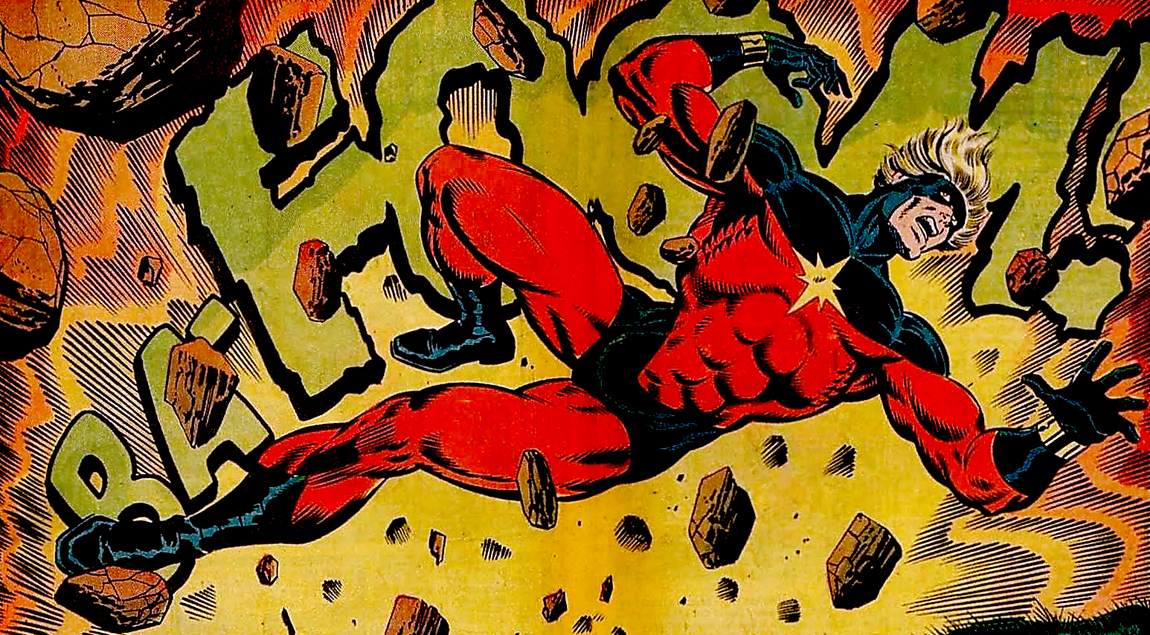The cameo appearance of Thanos during a post-credits teaser in the recent “Avengers” film, generated quite a bit of interest in the Marvel Comics work of Jim Starlin. Mr. Starlin created Thanos in 1973 and the character played the villain role in most of Mr. Starlin’s periodic work with Marvel.
I went back to the beginning and read Thanos’s first major appearance and story arc, which Marvel had conveniently collected in “Captain Marvel Masterworks Volume 3” – also known as #95 for those collecting the library ‘marble’ editions. It reprinted “Captain Marvel” issues #22-#33 and “Iron Man” issue #55.
Given that I was most interested in the material with Thanos by Mr. Starlin, I breezed through the first few issues in the volume. This was not out of disrespect for creators such as Gerry Conway or Marv Wolfman, but most collectors would agree that the “Captain Marvel” series was most-known for Mr. Starlin’s run on it. Prior to his arrival, there had been a series of creative shuffles and character revamps, as Marvel tried different changes in order to get Captain Marvel to better connect with audiences.
The first appearance of Thanos in “Iron Man” #55 was odd in that Mr. Starlin basically hijacked an Iron Man issue in order to spill out an epic ‘cosmic’ mythology. It was ridiculous in hindsight to think that Iron Man, being one of Marvel’s few ‘non-powered’ heroes, would be pitted again Thanos, a very powerful cosmic entity. Mr. Starlin probably realized that too, as the action focused more on the cosmic hero Dax The Destroyer, rather than Iron Man.
Wisely, the ‘Thanos saga’ moved – with Jim Starlin – to the more-natural title “Captain Marvel,” which starred the alien Kree warrior Mar-Vell. In Mr. Starlin’s first few issues of “Captain Marvel,” I could tell that he was still trying to figure out how to figure things out. In particular, Mr. Starlin seemed to struggle at trying to turn the story into something heavily philosophical, while also needing to adhere to the ‘action’ norms of the era. Thus, it was odd to find a melding of very edgy artistic concepts for the time – one page in “Captain Marvel” #28 has 35 panels, all but 1 is silent – with somewhat plodding flight scenes.
That one issue of “Iron Man” and then the following issues of “Captain Marvel” were Mr. Starlin’s first real work at Marvel and readers might tell that he was still at a very raw state in his career. His art was already top-notch but his writing was inconsistent. That said, he was pouring out crazy new ideas at such a rate that it was obvious that the he had a writing talent that simply needed more honing and editorial support.
The Thanos saga in “Captain Marvel” came out a couple of years after the legendary “Kree-Skrull War” in the “Avengers” series. Thematically, Mr. Starlin’s felt almost like a sequel to that story, with the Avengers popping up in most of the issues. They were not heavily involved, since Captain Marvel did most of the ‘heavy lifting’ in the story, but it was fun to have them around. Their presence only further added to an epic feel to the events.
This material helped me connect a few dots between the standard Marvel universe and some of their longstanding cosmic characters. The use of Saturn’s moon of Titan as the home base for Mr. Starlin’s new characters made it so that an entire advanced society could suddenly emerge, without having to involve complicated interstellar travel. Also, I finally learned a bit about the character of Moondragon, who was apparently from Titan. She was a character who had often popped up in various incarnations of the Avengers who I didn’t really have a connection to until learning more about her background.
A few things were frustrating about the material. First, as the ‘saga’ continued into subsequent chapters, retelling the back story resulted in a couple of pages in every issue being crammed with recap information. This was most likely an editorial mandate and consistent with practices of the era, but it led to rather-stale reading, especially since Marvel was only producing eighteen pages of story per issue at the time.
Also, I was never quite able to understand why Thanos didn’t immediately use the cosmic cube to crush his enemies. He seemed to toy with them in the second half of the saga, almost like a bad James Bond villain. Perhaps Mr. Starlin was trying to suggest a certain ‘learning curve’ associated with Thanos’s use of the cosmic cube’s powers, but that was not spelled out. The key to defeating Thanos, by playing on his ego, also seemed to be very forced. Mr. Starlin had elevated Thanos’s power to such a level that he seemed to struggle with a credible way to orchestrate Thanos’s defeat.
Those familiar with Mr. Starlin’s later work at Marvel would probably get a kick out of seeing how well-developed his mythology was so early in his career. I was most familiar with Mr. Starlin’s “Silver Surfer” work in the early 1990s and the “Infinity Gauntlet” and “Infinity War” series that he did around that time. By that point, Mr. Starlin would have been creating comic books for nearly twenty years and many of the problematic editorial mandates of the 1970s would have been eased. Thus, those stories were held up as being more ‘mainstream’ and have been more popular in the Marvel canon than his early “Captain Marvel” work.
For those following the chronology of Mr. Starlin’s ‘cosmic’ work at Marvel, the next logical stop would be his Warlock series. Those stories were similarly-serial in nature and also featured Thanos. They could be found in Marvel Masterworks #119 (Warlock Masterworks volume 2).
- “Masters of Doom” by David Kushner - December 16, 2023
- San Diego Comic-Con 2023 Analysis - July 29, 2023
- Star Wars: The Rise of Skywalker (2019) Reviewed - March 15, 2023
